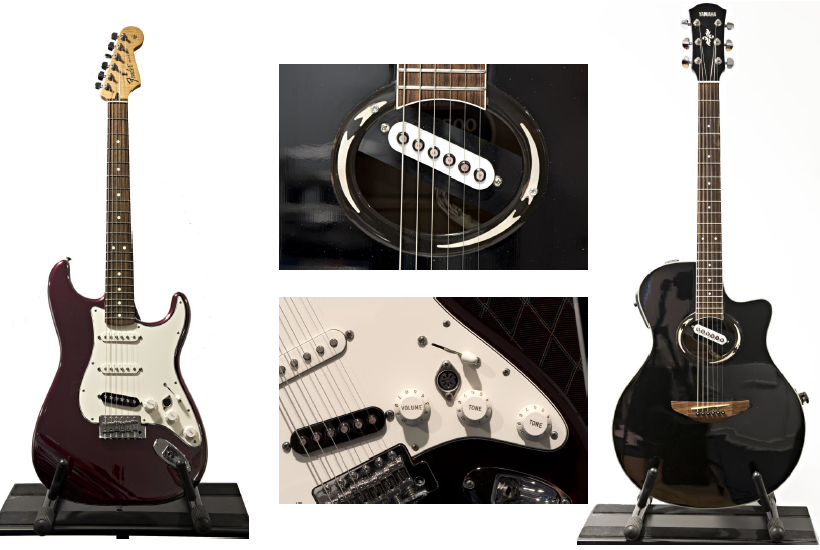This poster represents work done by Undergraduate Research students: Tom Lawson, Tom Weightman and Joe Callister, with supervision from Duncan Werner and Bruce Wiggins.
GASP performance and GASP production
GASP is an acronym for ‘Guitars with Ambisonic SpatialPerformance’ (GASP performance) however, it can also mean ‘Guitars with Ambisonic Spatial Production’ (GASP production). This is a new development for the GASP project team. GASP production utilizes ProTools for initial individual string capture and editing, followed by Guitar Rig processing to effect individual strings as either mono or ‘stereo’ timbres as a post-production exercise.

Guitar Rig
Guitar Rig is a virtual effects processor designed to reproduce a vast range of guitar timbres from simulated valve amplifier tones through all manner of digital effects.



Timbre processing using Guitar Rig
We use Guitar Rig as a ‘plugin’ to provide individual effects on individual strings. We can use Guitar Rig as a mono processor where each string is assigned its own unique timbre and then positioned in the spatial surround field.
Student involvement
The research project lends itself to include student participation in the creation of suitable multichannel guitar material with subsequent remixing opportunities or alternatively as a real-time performance system. A number of students have already made a contribution to the project by participating in the creation of suitable multichannel guitar-based material. Thanks go to Laura Birkin, Jack Saywer, CharlieMiddlicott and current researchers TomLawson, Tom Weightman and Joe Callister.
Aims and Objectives
- The aim of this part of the project was to create a Graphical User Interface (GUI) that more efficiently displayed panning information for 6 strings of the GASPguitar, with each comprising of two channels.
- To this end, the objectives were:
- Show six positions on the GUI, each representing the position of a string in 2D space.
- Allow each string to have an associated ‘spread’ where the two channels for each string deviated from this position.
- Graphically represent what happens to the sources when they are panned inside the speaker array(sources become more broad).
- Each parameter can be specified by the mouse, x & y coordinates, or azimuth & distance.
- All parameters must be automatable students.
The 3D Panner Problem
Although tools written by Dr Bruce Wiggins(WigWare ) are available and have been used throughout this project, utilising two panners per string, 6 stings per guitar, and multiple guitar tracks soon results in an unwieldy number of 3D panner graphical user interfaces being shown on the screen simultaeiously (12 per guitar track!). For this project, the student was tasked to tackle the GASP panner Graphical UserInterface Problem.






Guitars and pickups
We currently have two guitars used for the GASP project, a Fender Stratocaster and a Yamaha APX acoustic; both have been retrofitted with multichannel pickups(sometimes referred to as polyphonic, hexaphonic or divided pickups). The pickups are a bespoke design such that each guitar string gives its own individual audio output, therefore allowing each string to be individually processed; The pickups are manufactured and supplied by ‘Ubertar Hexaphonic Pickups’


Compression
Usually, an electric guitar has one audio output which is a combination of the output from all 6 strings. However, in this project, each string has its own dedicated output which can then be spatialized and effected separately which enables the instrument to be used in a very different and unique way when compared to a standard electric guitar. Our previous work has identified that different performance techniques by individual performers mean there are variations in string pluck pressure. This results in some string amplitudes at a very low level and some which overload the input stage of the recording system. The solution to this problem is an in-line audio compressor for each individual channel which will allow for any amplitude variations to be “evened out”.
Future GASP production ideas to consider
- Bring out “shreds” onto dedicated track – treat as feature
- Investigate relationship of time in-between notes slow strum or picking style with time delays and location/direction
- Process low notes as bass – octave shift
- Experiment with big clean rhythm sound, single clean delay, try with Yamaha Acoustic
- Try lower three strings dedicated timbre vs upper three strings different dedicated timbre
- Capture and separate slides
- Extract short melodies and combine onto one track
- Consider educational aspects of separate strings – analysis of performance at micro level
- Use of full chords, then apply subtractive composition techniques
- Explore spatial separation of dissonant elements
- Extract modulation ‘FM’ – string bend on chords
- Level of programme material vs ability to localise i.e. relationship of level (SPL) to position
- Integration of discrete string parts and timbre selection into Ableton for alternative performance method
- Rotate the room! Investigate automation of B format to simulate effect of room rotation (the whole mix)
Outcomes
- New GASP 2D audio panning software has been created enabling faster and more usable parameter modulation for positional audio.
- Production work-flow and channel routing methodology has been realised in order to allow for flexible routing and management of the many channels and audio stems needed to implement the system.
- A number of new compositions have been created, investigated and mixed to enable a talk and demonstration to be shown at the Sounds in Space Research Symposium in June 2015.
- Creation of style and timbral presets for surround performance.